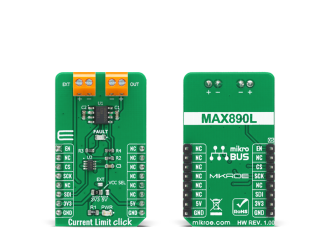
We strongly encourage users to use Package manager for sharing their code on Libstock website, because it boosts your efficiency and leaves the end user with no room for error. [more info]

Rating:
Author: MIKROE
Last Updated: 2021-01-29
Package Version: 1.0.0.0
mikroSDK Library: 1.0.0.0
Category: Power Switch
Downloaded: 3621 times
Not followed.
License: MIT license
Current Limit Click is a compact add-on board that contains a low-voltage, P-channel MOSFET power switch intended for high-side load switching applications. This board features the MAX890L, a low-resistance power switch with the adjustable, accurate current limit system, and thermal shutdown from Maxim Integrated.
Do you want to subscribe in order to receive notifications regarding "Current Limit click" changes.
Do you want to unsubscribe in order to stop receiving notifications regarding "Current Limit click" changes.
Do you want to report abuse regarding "Current Limit click".


Library Description
The library covers necessary functions that enables the usage of the Current Limit click board. User can check or set current limit or enable/disable the device.
Key functions:
void currentlimit_dev_enable ( uint8_t state ); - Function is used to enable or disable the device.void currentlimit_set_limit ( uint8_t lim_val ); - Function is used to set the current limit with predefined values.void currentlimit_set_limit_calc ( float lim_val ); - Function is used to set the current limit with calculacion.Examples description
The application is composed of three sections :
void application_task ( )
{
char inx;
if ( UART_Rdy_Ptr() )
{
inx = UART_Rd_Ptr( );
inx -=48;
currentlimit_set_limit( lim_val[ inx - 1 ] );
mikrobus_logWrite("Data sent successfully!", _LOG_LINE );
}
}
Other mikroE Libraries used in the example:
Additional notes and informations
Depending on the development board you are using, you may need USB UART click, USB UART 2 click or RS232 click to connect to your PC, for development systems with no UART to USB interface available on the board. The terminal available in all MikroElektronika compilers, or any other terminal application of your choice, can be used to read the message.